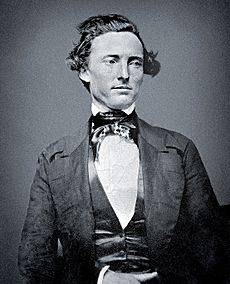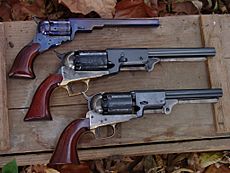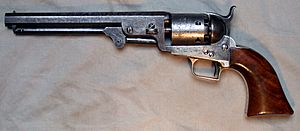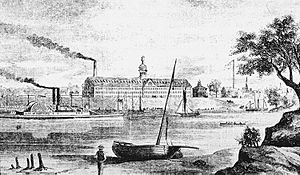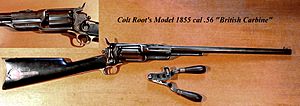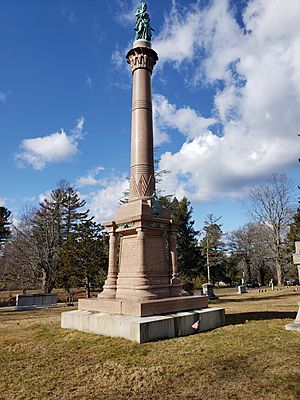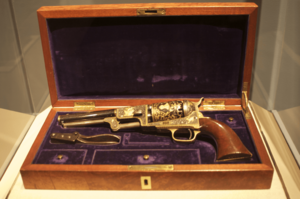Samuel Colt facts for kids
Quick facts for kids
Samuel Colt
|
|
|---|---|
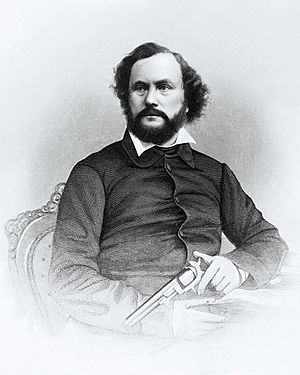
Samuel Colt in 1855
|
|
| Born | July 19, 1814 Hartford, Connecticut, U.S.
|
| Died | January 10, 1862 (aged 47) Hartford, Connecticut, U.S.
|
| Resting place | Cedar Hill Cemetery, Hartford, Connecticut, U.S. |
| Occupation | Inventor, industrialist, businessman, hunter |
| Spouse(s) | Elizabeth Hart Jarvis (m. 1856–1862) |
| Relatives |
|
| Awards | Telford Medal |
| Signature | |
Samuel Colt (born July 19, 1814 – died January 10, 1862) was an American inventor and businessman. He started the Colt's Patent Fire-Arms Manufacturing Company, which is now known as Colt's Manufacturing Company. He made it possible to produce revolvers in large numbers, making them available to many people.
Colt's first two attempts at business, making firearms and underwater mines, did not go well. However, his business grew quickly after 1847. This was when the Texas Rangers ordered 1,000 revolvers during the war with Mexico. Later, his firearms were widely used as people moved west across the American frontier.
Colt's ways of making things were very advanced for his time. He used interchangeable parts, which meant that all parts of a gun were made exactly the same. This helped him be one of the first to use the assembly line effectively. He also used new ways to advertise his products, like using art, getting famous people to support his products, and giving gifts. This made him a leader in advertising and mass marketing.
Contents
Early Life and Big Ideas (1814–1835)
Samuel Colt was born in Hartford, Connecticut. His father was a farmer who later became a businessman. Samuel's mother died when he was six years old.
When Samuel was 11, he worked for a farmer. He also went to school there. He loved reading a science encyclopedia called the Compendium of Knowledge. This book, especially articles about inventors like Robert Fulton and gunpowder, inspired him. He saw that other inventors had done things that seemed impossible, and he wanted to do the same. After hearing soldiers say a gun could never shoot five or six times without reloading, Colt decided he would create that "impossible gun."
How Did Colt Get His First Revolver Idea?
In 1829, at age 15, Colt started working at his father's textile factory. He had access to tools and materials there. He built a homemade galvanic cell (a type of battery). For a Fourth of July event, he advertised that he would explode a raft on Ware Pond using underwater explosives. He missed the raft, but the explosion was still impressive!
In 1830, a fire caused by a Fourth of July accident ended his schooling. His father then sent him to learn to be a sailor. On a trip to Calcutta on a ship called the Corvo, Colt got an idea for a new type of revolver. He was inspired by the ship's capstan, which had a special turning mechanism. He realized he could use a similar mechanism to make a gun's cylinder turn automatically when the hammer was pulled back. On the ship, he made a wooden model of his idea.
Earning Money for His Inventions
When Colt returned to the United States in 1832, he worked for his father again. His father helped him make two guns, a rifle and a pistol. The pistol exploded when fired, but the rifle worked well. Since his father would not pay for more development, Samuel needed to find money.
He had learned about nitrous oxide (laughing gas) from a chemist. So, he traveled around the United States and Canada, performing laughing gas demonstrations. He called himself "the Celebrated Dr. Coult." He believed that if he could show people a new idea like laughing gas, they would be more open to his new revolver idea. These shows helped him save money.
Developing the Revolver Design
With some money saved, Colt decided to work with real gunsmiths in Baltimore, Maryland. He changed his idea from a gun with many barrels to a single fixed barrel with a rotating cylinder. He wanted the hammer's action to line up the cylinder with the barrel.
A friend of his father, Henry Leavitt Ellsworth, loaned him $300. Ellsworth told him to make his gun perfect before applying for a patent. Colt hired a gunsmith named John Pearson. Over the next few years, they improved the design. By 1835, Colt was ready to apply for his U.S. patent. Ellsworth, who was now in charge of the U.S. Patent Office, told Colt to get foreign patents first. This was because a U.S. patent would stop him from getting one in the United Kingdom. In August 1835, Colt went to England and France to get his foreign patents.
Colt's First Revolver (1835–1843)
In 1835, Samuel Colt went to the United Kingdom. He was granted his first patent there (number 6909). When he returned to America, he applied for his U.S. patent for a "revolving gun." He received the patent on February 25, 1836. This patent protected the main ideas of his revolving, breech-loading, folding trigger firearm, which he called the Colt Paterson.
With a loan from his cousin and help from Ellsworth, Colt started a company in 1836. This company, the Patent Arms Manufacturing Company of Paterson, New Jersey, was officially formed on March 5, 1836. Colt received money for each gun sold and would get his patent rights back if the company closed.
Colt never said he invented revolvers. His design was a more practical version of an earlier revolving gun. Colt's big contribution was using interchangeable parts. He imagined that all parts of every Colt gun would be made by machine and then put together by hand. His goal was to create an assembly line.
Colt's U.S. revolver patent gave him the sole right to make revolvers until 1857. His was the first practical revolver and the first practical repeating firearm. This was thanks to new percussion technology, which made guns more reliable and safer. The revolver became a very important invention, even leading to one of his company's later guns being called the "Peacemaker."
Early Challenges and Setbacks
By the end of 1837, the Arms Company had made over 1,000 weapons, but they were not selling. After a financial crisis in 1837, the company's backers did not want to pay for the new machines Colt needed for interchangeable parts. So, he traveled to raise money.
He showed his gun to people in stores, but it did not create enough sales. With another loan from his cousin, he went to Washington, D.C. He showed the gun to President Andrew Jackson. Jackson liked the gun and wrote Colt a note saying so. With this letter, Colt got Congress to approve a demonstration for the military. However, he could not get money for the military to buy the weapons. An order from South Carolina for 50 to 75 pistols was canceled because the company could not make them fast enough.
Colt also faced problems because of a law from 1808. This law said that any weapons bought by a state militia had to be currently used by the U.S. military. This stopped state militias from buying experimental weapons.
Colt's company also struggled because of his spending. He spent company money on expensive clothes and gifts for potential clients. He even tried to get customers to buy more by offering them drinks and fancy dinners.
The company was briefly saved by the Second Seminole War in Florida. This led to the first sales of Colt's revolvers and his new revolving rifles. Soldiers in Florida liked the new weapon. However, the gun's design was unusual, and many soldiers took the parts apart, causing them to break. Colt soon changed his design to have an exposed hammer, but problems continued. In late 1843, the Paterson factory closed, and a public auction was held to sell the company's assets.
New Inventions and a Comeback (1843–1860)
Colt did not stop inventing for long. He started selling his own underwater electrical detonators and waterproof cables. After his first company failed, he worked with Samuel Morse to get money from the U.S. government. Colt's waterproof cable, made from tar-coated copper, was very useful when Morse laid telegraph lines under lakes and rivers.
In 1841, with tensions rising with the British, Congress gave money for Colt's project. He showed his underwater mines to the U.S. government. In 1842, he used one of his devices to destroy a moving ship, which impressed the United States Navy and President John Tyler. However, a politician named John Quincy Adams stopped the project. He called the Colt mine "not fair and honest warfare" and an "unchristian contraption."
Improving Ammunition
After this setback, Colt focused on making better tinfoil cartridges for his revolvers. At the time, gunpowder and bullets were wrapped in paper or skin. If the paper got wet, the powder would be ruined. Colt tried different materials and decided to use a thin type of tinfoil. In 1841, he made samples for the army. Tests showed that the tinfoil left no residue in the gun barrel. In 1843, the army ordered 200,000 tinfoil cartridges.
With the money from the cartridges, Colt went back to business with Morse. Colt focused on making his waterproof telegraph cable. He believed this business would grow with Morse's invention. He promoted telegraph companies to create a bigger market for his cable. He tried to use this money to restart his old gun company, but he could not get funds from other investors. This gave Colt time to improve his revolver design. He had a gunsmith build a prototype for his "New and improved revolver." This new revolver had a fixed trigger and a larger caliber. Colt showed this prototype to the War Department as a "Holster revolver."
Colt's Patent Manufacturing Company
Captain Samuel Walker of the Texas Rangers had used Colt revolvers during the Seminole War. He saw how effective they were when his 15-man unit defeated 70 Comanches in Texas. Walker wanted to order Colt revolvers for the Rangers to use in the Mexican–American War. He met Colt in New York City on January 4, 1847, and ordered 1,000 revolvers.
Walker asked for some changes: the new revolvers needed to hold 6 shots instead of 5, be powerful enough to kill a human or a horse with one shot, and be quicker to reload. This large order allowed Colt to start a new firearms business. Colt hired Eli Whitney Blake, who was already in the arms business, to make his guns. Colt used his prototype and Walker's ideas to create a new design. From this design, Blake produced the first 1,000 guns, known as the Colt Walker. The company then received another order for 1,000 more. Colt earned $10 per pistol from these orders.
With the money from these sales and a loan from his cousin, Colt bought the machines and tools from Blake to build his own factory. This was the Colt's Patent Fire-Arms Manufacturing Company factory in Hartford. The first pistols made there were called "Whitneyville-Hartford-Dragoons." They became so popular that "Colt" was often used as a general name for revolvers. Starting in 1848, more orders came for what are now known as the Colt Dragoon Revolvers. These models were based on the Walker Colts, with small improvements over time.
Colt's revolvers were used by both civilians and soldiers. They were a key tool during the westward expansion of America. A revolver that could fire six times without reloading helped soldiers and settlers defend themselves against larger groups. In 1848, Colt introduced smaller pistols called Baby Dragoons for civilian use.
In 1850, Generals Sam Houston and Thomas Jefferson Rusk convinced the Secretary of War and President James K. Polk to use Colt's revolvers for the U.S. military. Rusk said, "Colt's Repeating Arms are the most efficient weapons in the world." Colt used this general design for the Colt 1851 Navy Revolver. This gun became the standard sidearm for U.S. military officers and was also popular with civilians.
Protecting His Inventions
During this time, Colt received an extension on his patent. This was because he did not earn much money from it in the early years. Colt strongly protected his patent rights. Even though he had the only legal patent for his type of revolver, many people copied his work. Colt was constantly in court. His lawyer, Edward N. Dickerson, successfully stopped the competition.
However, Colt's strong protection of his patents also slowed down the development of firearms in the United States. His focus on lawsuits meant his own company was slow to switch to the cartridge system. It also stopped other companies from making new revolver designs. At the same time, Colt's policies forced some inventors to be more creative, as they had to find new ways around his patents.
Colt knew his revolvers had to be affordable. He set his prices lower than his competitors to sell as many as possible. He also invested money in improving his machines. This made it harder for others to make a similar weapon at a lower price. However, his focus on marketing and patents made him miss a big opportunity. He dismissed an idea from one of his gunsmiths, Rollin White. White had an idea for a "bored-through" revolver cylinder, which would allow cartridges to be loaded from the back. A year after White left Colt, Colt's competitor, Smith & Wesson, used White's patent. This stopped Colt from being able to build cartridge firearms for almost 20 years.
Colt's Factories
Hartford Factory
Colt bought a large piece of land next to the Connecticut River. He built his first factory there in 1848, and a larger factory called the Colt Armory in 1855. He also built his home, Armsmear, in 1856, and housing for his employees. He set up a ten-hour workday, provided washing stations, and gave a one-hour lunch break. He also built the Charter Oak Hall, where employees could play games and read newspapers. Colt ran his factory with strict rules. He would fire workers for being late, doing poor work, or even suggesting improvements to his designs.
Colt hired Elisha K. Root as his main mechanic. Root was very good at setting up machines. He created special machines for Colt's factory that did most of the work. This meant that less than 20% of the gun parts needed to be finished by hand. Colt's factory was the first to truly use the assembly line concept successfully.
Colt wanted his revolvers to feel handmade, so he insisted on a final hand finish and polish. He hired skilled gun makers from Germany and used special techniques for engraving the steel, especially on the cylinders. He also hired a German engraver, Gustave Young, for very fine hand engraving on his special custom guns. To attract skilled European workers, Colt built a village near the factory called Coltsville. He even planted willow trees to create a dike to stop flooding from the river and later built a factory to make wicker furniture from these trees.
On June 5, 1856, Colt married Elizabeth Jarvis. Their wedding was grand, held on a steamship overlooking the factory, with fireworks and gun salutes. They had four children, but sadly, three died as babies. Their son, Caldwell Hart Colt, was born in 1858.
London Factory
Soon after building his Hartford factory, Colt decided to open a factory in Europe. He chose London. He had a big display of his firearms at the Great Exhibition of 1851 in Hyde Park, London. He impressed people by taking apart ten guns and putting ten new ones together using different parts from different guns. This showed how well his interchangeable parts worked. Colt gave a speech about mass production to the Institution of Civil Engineers (ICE) in London and received a medal.
With help from the ICE secretary, Colt opened his London factory on January 1, 1853. This factory mass-produced parts that were completely interchangeable. This meant unskilled workers could put them together on assembly lines, unlike English gun makers who made each part by hand. Colt's London factory only operated for four years. He did not want to change his gun design to what the British wanted, so he sold only about 23,000 revolvers to the British Army and Navy. In 1856, he closed the London plant and sent all the machines and unfinished guns back to Hartford.
Smart Marketing Strategies
When foreign leaders would not meet him because he was just a private citizen, Colt convinced the governor of Connecticut to make him a lieutenant colonel in the state militia. With this new rank, he traveled Europe again to promote his revolvers. He used very new marketing techniques for the time.
He often gave custom-engraved revolvers as gifts to leaders, military officers, and famous people like Giuseppe Garibaldi and King Victor Emmanuel II of Italy. Colt hired western artist George Catlin to paint scenes where a Colt weapon was clearly used against Native Americans, wild animals, or bandits. This was an early form of "product placement" advertising. He also put many ads in newspapers. He even paid authors to write stories about his guns for magazines and travel guides. One of his biggest self-promotion acts was paying a magazine to publish a 29-page story with pictures showing how his factory worked.
After his revolvers became popular, Colt had his staff look for news stories that mentioned his guns. He would then reprint these stories. He even hired people in other states to find such stories, buy hundreds of copies, and give the editor a free revolver for writing them, especially if the story spoke badly about his competitors. Many of the revolvers Colt gave away had messages like "Compliments of Col. Colt" engraved on them. Later, his full signature was used in many advertisements, making his fame a guarantee of his weapons' quality. Colt eventually got a trademark for his signature.
One of his famous slogans was, “God created men, Col. Colt made them equal.” This meant that anyone, no matter their physical strength, could defend themselves with a Colt gun. This saying became very popular in American culture.
Later Years and Legacy
Before the American Civil War, Colt sold firearms to both the North and the South. He had a history of selling weapons to both sides of conflicts in Europe, and he did the same during the war in America. In 1859, Colt thought about building a factory in the South. As late as 1861, he sold 2,000 revolvers to a Confederate agent. Even though trade with the South was not restricted at that time, newspapers called him a Southern supporter and a traitor. In response, Colt was made a colonel by the state of Connecticut on May 16, 1861. He was put in charge of the 1st Regiment Colts Revolving Rifles of Connecticut, armed with his Colt revolving rifle. However, this unit was never sent to fight, and Colt was discharged on June 20, 1861.
Samuel Colt died in Hartford on January 10, 1862, from complications of gout. He was buried on his private property, Armsmear, and later reburied in Cedar Hill Cemetery in 1894. At the time of his death, Colt's estate was worth about $15,000,000. He left his wealth to his wife and three-year-old son, Caldwell Hart Colt. His business responsibilities went to his brother-in-law, Richard Jarvis.
It is believed that in its first 25 years, Colt's company produced over 400,000 revolvers. Before his death, each gun barrel was stamped with "Address Col. Samuel Colt, New York, US America," or a similar message with a London address. Colt did this because New York and London were major cities, and he had an office in New York where his salesmen worked.
Colt was the first American manufacturer to use art for marketing. He hired Catlin to show Colt firearms in his paintings. He also won many government contracts by giving highly decorated and engraved revolvers with fancy grips to government officials. On a visit to Constantinople, he gave a custom-engraved, gold-inlaid revolver to the Sultan of the Ottoman Empire, Abdülmecid I. He told the Sultan that the Russians were buying his pistols, which helped him get an order for 5,000 pistols from Turkey. He had used the same tactic with the Russians to get their order!
Besides gifts, Colt had a very effective marketing plan. He used the news to his advantage by giving revolvers to editors. He encouraged them to report "all the accidents that occur to the Sharps & other humbug arms" and list times when Colt weapons were "well used against bears, Indians, Mexicans, etc." Colt's firearms did not always do well in official military tests. He preferred written stories from individual soldiers who used his weapons, and he relied on these to get government contracts.
Colt believed that even bad press was useful, as long as his name and revolvers were mentioned. When he opened his London factory, he put a 14-foot sign on the roof across from Parliament that read: "Colonel Colt's Pistol Factory." This was a publicity stunt that the British press noticed. Eventually, the British government made him remove the sign. Colt was a pioneer in modern marketing. He was one of the first to use celebrity endorsements, introduced the phrase "new and improved" to advertising, and showed the value of a brand name. In French, the word for "revolver" is le colt.
In 1867, Colt's widow, Elizabeth, had an Episcopal church built as a memorial to him and their three children who died. The church's design includes gun and gun-making tools carved in marble to honor Colt's life as an arms maker. In 1896, a parish house was built there to remember their son, Caldwell. In 1975, the Church of the Good Shepherd and Parish House was listed as a historic place.
Colt set up libraries and educational programs in his factories for his employees. These programs trained many generations of toolmakers and other machinists. These skilled workers later had a big impact on other manufacturing efforts for the next 50 years.
In 2006, Samuel Colt was added to the National Inventors Hall of Fame.
Images for kids
See also
 In Spanish: Samuel Colt para niños
In Spanish: Samuel Colt para niños


